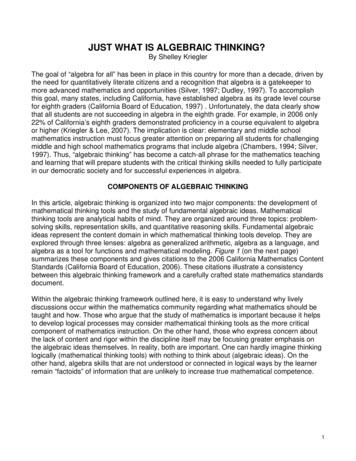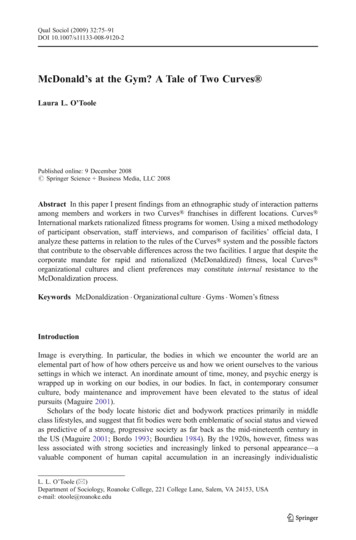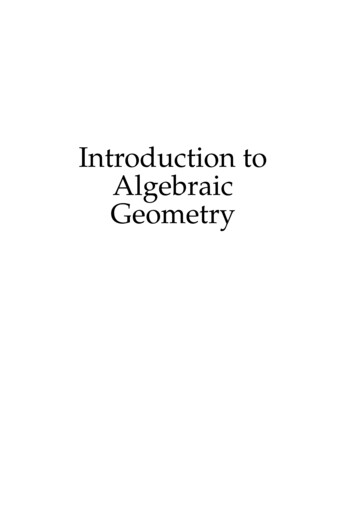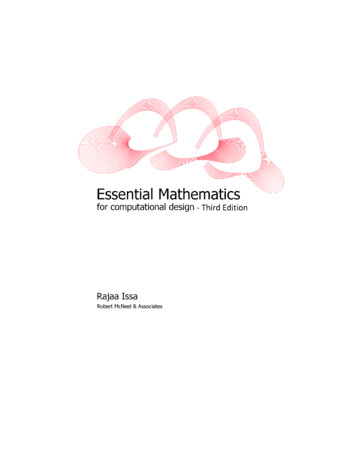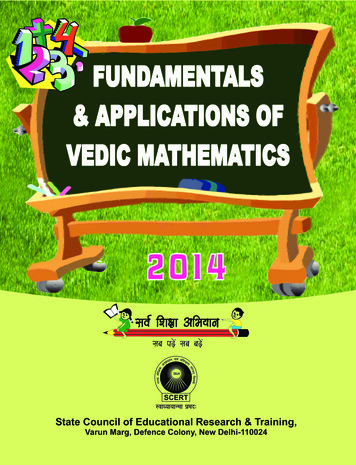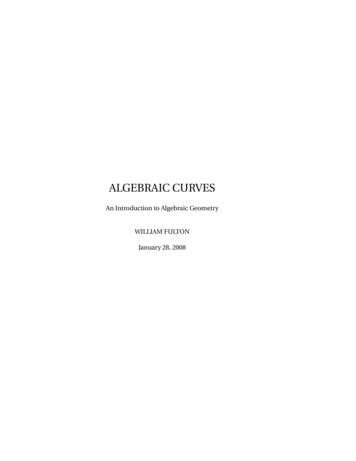
Transcription
ALGEBRAIC CURVESAn Introduction to Algebraic GeometryWILLIAM FULTONJanuary 28, 2008
PrefaceThird Preface, 2008This text has been out of print for several years, with the author holding copyrights. Since I continue to hear from young algebraic geometers who used this astheir first text, I am glad now to make this edition available without charge to anyoneinterested. I am most grateful to Kwankyu Lee for making a careful LaTeX version,which was the basis of this edition; thanks also to Eugene Eisenstein for help withthe graphics.As in 1989, I have managed to resist making sweeping changes. I thank all whohave sent corrections to earlier versions, especially Grzegorz Bobiński for the mostrecent and thorough list. It is inevitable that this conversion has introduced somenew errors, and I and future readers will be grateful if you will send any errors youfind to me at wfulton@umich.edu.Second Preface, 1989When this book first appeared, there were few texts available to a novice in modern algebraic geometry. Since then many introductory treatises have appeared, including excellent texts by Shafarevich, Mumford, Hartshorne, Griffiths-Harris, Kunz,Clemens, Iitaka, Brieskorn-Knörrer, and Arbarello-Cornalba-Griffiths-Harris.The past two decades have also seen a good deal of growth in our understandingof the topics covered in this text: linear series on curves, intersection theory, andthe Riemann-Roch problem. It has been tempting to rewrite the book to reflect thisprogress, but it does not seem possible to do so without abandoning its elementarycharacter and destroying its original purpose: to introduce students with a little algebra background to a few of the ideas of algebraic geometry and to help them gainsome appreciation both for algebraic geometry and for origins and applications ofmany of the notions of commutative algebra. If working through the book and itsexercises helps prepare a reader for any of the texts mentioned above, that will be anadded benefit.i
iiPREFACEFirst Preface, 1969Although algebraic geometry is a highly developed and thriving field of mathematics, it is notoriously difficult for the beginner to make his way into the subject.There are several texts on an undergraduate level that give an excellent treatment ofthe classical theory of plane curves, but these do not prepare the student adequatelyfor modern algebraic geometry. On the other hand, most books with a modern approach demand considerable background in algebra and topology, often the equivalent of a year or more of graduate study. The aim of these notes is to develop thetheory of algebraic curves from the viewpoint of modern algebraic geometry, butwithout excessive prerequisites.We have assumed that the reader is familiar with some basic properties of rings,ideals, and polynomials, such as is often covered in a one-semester course in modern algebra; additional commutative algebra is developed in later sections. Chapter1 begins with a summary of the facts we need from algebra. The rest of the chapteris concerned with basic properties of affine algebraic sets; we have given Zariski’sproof of the important Nullstellensatz.The coordinate ring, function field, and local rings of an affine variety are studiedin Chapter 2. As in any modern treatment of algebraic geometry, they play a fundamental role in our preparation. The general study of affine and projective varietiesis continued in Chapters 4 and 6, but only as far as necessary for our study of curves.Chapter 3 considers affine plane curves. The classical definition of the multiplicity of a point on a curve is shown to depend only on the local ring of the curve at thepoint. The intersection number of two plane curves at a point is characterized by itsproperties, and a definition in terms of a certain residue class ring of a local ring isshown to have these properties. Bézout’s Theorem and Max Noether’s Fundamental Theorem are the subject of Chapter 5. (Anyone familiar with the cohomology ofprojective varieties will recognize that this cohomology is implicit in our proofs.)In Chapter 7 the nonsingular model of a curve is constructed by means of blowing up points, and the correspondence between algebraic function fields on onevariable and nonsingular projective curves is established. In the concluding chapterthe algebraic approach of Chevalley is combined with the geometric reasoning ofBrill and Noether to prove the Riemann-Roch Theorem.These notes are from a course taught to Juniors at Brandeis University in 1967–68. The course was repeated (assuming all the algebra) to a group of graduate students during the intensive week at the end of the Spring semester. We have retainedan essential feature of these courses by including several hundred problems. The results of the starred problems are used freely in the text, while the others range fromexercises to applications and extensions of the theory.From Chapter 3 on, k denotes a fixed algebraically closed field. Whenever convenient (including without comment many of the problems) we have assumed k tobe of characteristic zero. The minor adjustments necessary to extend the theory toarbitrary characteristic are discussed in an appendix.Thanks are due to Richard Weiss, a student in the course, for sharing the taskof writing the notes. He corrected many errors and improved the clarity of the text.Professor Paul Monsky provided several helpful suggestions as I taught the course.
iii“Je n’ai jamais été assez loin pour bien sentir l’application de l’algèbre à la géométrie.Je n’ai mois point cette manière d’opérer sans voir ce qu’on fait, et il me sembloit querésoudre un probleme de géométrie par les équations, c’étoit jouer un air en tournant une manivelle. La premiere fois que je trouvai par le calcul que le carré d’unbinôme étoit composé du carré de chacune de ses parties, et du double produit del’une par l’autre, malgré la justesse de ma multiplication, je n’en voulus rien croirejusqu’à ce que j’eusse fai la figure. Ce n’étoit pas que je n’eusse un grand goût pourl’algèbre en n’y considérant que la quantité abstraite; mais appliquée a l’étendue, jevoulois voir l’opération sur les lignes; autrement je n’y comprenois plus rien.”Les Confessions de J.-J. Rousseau
ivPREFACE
ContentsPrefacei1 Affine Algebraic Sets1.1 Algebraic Preliminaries . . . . . . . . . . . .1.2 Affine Space and Algebraic Sets . . . . . . . .1.3 The Ideal of a Set of Points . . . . . . . . . . .1.4 The Hilbert Basis Theorem . . . . . . . . . .1.5 Irreducible Components of an Algebraic Set1.6 Algebraic Subsets of the Plane . . . . . . . .1.7 Hilbert’s Nullstellensatz . . . . . . . . . . . .1.8 Modules; Finiteness Conditions . . . . . . .1.9 Integral Elements . . . . . . . . . . . . . . . .1.10 Field Extensions . . . . . . . . . . . . . . . . .2 Affine Varieties2.1 Coordinate Rings . . . . . . . . . . . . . .2.2 Polynomial Maps . . . . . . . . . . . . . .2.3 Coordinate Changes . . . . . . . . . . . .2.4 Rational Functions and Local Rings . . .2.5 Discrete Valuation Rings . . . . . . . . . .2.6 Forms . . . . . . . . . . . . . . . . . . . . .2.7 Direct Products of Rings . . . . . . . . . .2.8 Operations with Ideals . . . . . . . . . . .2.9 Ideals with a Finite Number of Zeros . . .2.10 Quotient Modules and Exact Sequences .2.11 Free Modules . . . . . . . . . . . . . . . .114567910121415.1717181920222425252627293 Local Properties of Plane Curves313.1 Multiple Points and Tangent Lines . . . . . . . . . . . . . . . . . . . . . . 313.2 Multiplicities and Local Rings . . . . . . . . . . . . . . . . . . . . . . . . . 343.3 Intersection Numbers . . . . . . . . . . . . . . . . . . . . . . . . . . . . . 36v
viCONTENTS4 Projective Varieties4.1 Projective Space . . . . . . . . .4.2 Projective Algebraic Sets . . . .4.3 Affine and Projective Varieties4.4 Multiprojective Space . . . . .43434448505 Projective Plane Curves5.1 Definitions . . . . . . . . . . . . . . . . .5.2 Linear Systems of Curves . . . . . . . .5.3 Bézout’s Theorem . . . . . . . . . . . . .5.4 Multiple Points . . . . . . . . . . . . . .5.5 Max Noether’s Fundamental Theorem .5.6 Applications of Noether’s Theorem . . .535355575960626 Varieties, Morphisms, and Rational Maps6.1 The Zariski Topology . . . . . . . . . . . . . . . . . . . .6.2 Varieties . . . . . . . . . . . . . . . . . . . . . . . . . . .6.3 Morphisms of Varieties . . . . . . . . . . . . . . . . . . .6.4 Products and Graphs . . . . . . . . . . . . . . . . . . . .6.5 Algebraic Function Fields and Dimension of Varieties6.6 Rational Maps . . . . . . . . . . . . . . . . . . . . . . . .676769707375777 Resolution of Singularities7.1 Rational Maps of Curves . . . .7.2 Blowing up a Point in A2 . . . .7.3 Blowing up Points in P2 . . . .7.4 Quadratic Transformations . .7.5 Nonsingular Models of Curves.8181828687928 Riemann-Roch Theorem8.1 Divisors . . . . . . . . . . . . .8.2 The Vector Spaces L(D) . . .8.3 Riemann’s Theorem . . . . .8.4 Derivations and Differentials8.5 Canonical Divisors . . . . . .8.6 Riemann-Roch Theorem . . .979799101104106108.A Nonzero Characteristic113B Suggestions for Further Reading115C Notation117
Chapter 1Affine Algebraic Sets1.1 Algebraic PreliminariesThis section consists of a summary of some notation and facts from commutative algebra. Anyone familiar with the italicized terms and the statements made hereabout them should have sufficient background to read the rest of the notes.When we speak of a ring, we shall always mean a commutative ring with a multiplicative identity. A ring homomorphism from one ring to another must take themultiplicative identity of the first ring to that of the second. A domain, or integraldomain, is a ring (with at least two elements) in which the cancellation law holds. Afield is a domain in which every nonzero element is a unit, i.e., has a multiplicativeinverse.Z will denote the domain of integers, while Q, R, and C will denote the fields ofrational, real, complex numbers, respectively.Any domain R has a quotient field K , which is a field containing R as a subring,and any elements in K may be written (not necessarily uniquely) as a ratio of twoelements of R. Any one-to-one ring homomorphism from R to a field L extendsuniquely to a ring homomorphism from K to L. Any ring homomorphism from afield to a nonzero ring is one-to-one.For any ring R, R[X ] denotes the ring of polynomials with coefficients in R. ThePdegree of a nonzero polynomial a i X i is the largest integer d such that a d 6 0; thepolynomial is monic if a d 1.The ring of polynomials in n variables over R is written R[X 1 , . . . , X n ]. We oftenwrite R[X , Y ] or R[X , Y , Z ] when n 2 or 3. The monomials in R[X 1 , . . . , X n ] are theiiipolynomials X 11 X 22 · · · X nn , i j nonnegative integers; the degree of the monomial isPi 1 · · · i n . Every F R[X 1 , . . . , X n ] has a unique expression F a (i ) X (i ) , where theX (i ) are the monomials, a (i ) R. We call F homogeneous, or a form, of degree d , if allcoefficients a (i ) are zero except for monomials of degree d . Any polynomial F has aunique expression F F 0 F 1 · · · F d , where F i is a form of degree i ; if F d 6 0, d isthe degree of F , written deg(F ). The terms F 0 , F 1 , F 2 , . . . are called the constant, linear, quadratic, . . . terms of F ; F is constant if F F 0 . The zero polynomial is allowed1
2CHAPTER 1. AFFINE ALGEBRAIC SETSto have any degree. If R is a domain, deg(F G) deg(F ) deg(G). The ring R is a subring of R[X 1 , . . . , X n ], and R[X 1 , . . . , X n ] is characterized by the following property: ifϕ is a ring homomorphism from R to a ring S, and s 1 , . . . , s n are elements in S, thenthere is a unique extension of ϕ to a ring homomorphism ϕ̃ from R[X 1 , . . . , X n ] to Ssuch that ϕ̃(X i ) s i , for 1 i n. The image of F under ϕ̃ is written F (s 1 , . . . , s n ).The ring R[X 1 , . . . , X n ] is canonically isomorphic to R[X 1 , . . . , X n 1 ][X n ].An element a in a ring R is irreducible if it is not a unit or zero, and for any factorization a bc, b, c R, either b or c is a unit. A domain R is a unique factorizationdomain, written UFD, if every nonzero element in R can be factored uniquely, up tounits and the ordering of the factors, into irreducible elements.If R is a UFD with quotient field K , then (by Gauss) any irreducible element F R[X ] remains irreducible when considered in K [X ]; it follows that if F and G arepolynomials in R[X ] with no common factors in R[X ], they have no common factorsin K [X ].If R is a UFD, then R[X ] is also a UFD. Consequently k[X 1 , . . . , X n ] is a UFD forany field k. The quotient field of k[X 1 , . . . , X n ] is written k(X 1 , . . . , X n ), and is calledthe field of rational functions in n variables over k.If ϕ : R S is a ring homomorphism, the set ϕ 1 (0) of elements mapped to zerois the kernel of ϕ, written Ker(ϕ). It is an ideal in R. And ideal I in a ring R is properif I 6 R. A proper ideal is maximal if it is not contained in any larger proper ideal. Aprime ideal is an ideal I such that whenever ab I , either a I or b I .PA set S of elements of a ring R generates an ideal I { a i s i s i S, a i R}. Anideal is finitely generated if it is generated by a finite set S { f 1 , . . . , f n }; we then writeI ( f 1 , . . . , f n ). An ideal is principal if it is generated by one element. A domain inwhich every ideal is principal is called a principal ideal domain, written PID. Thering of integers Z and the ring of polynomials k[X ] in one variable over a field k areexamples of PID’s. Every PID is a UFD. A principal ideal I (a) in a UFD is prime ifand only if a is irreducible (or zero).Let I be an ideal in a ring R. The residue class ring of R modulo I is written R/I ;it is the set of equivalence classes of elements in R under the equivalence relation:a b if a b I . The equivalence class containing a may be called the I -residue of a;it is often denoted by a. The classes R/I form a ring in such a way that the mappingπ : R R/I taking each element to its I -residue is a ring homomorphism. The ringR/I is characterized by the following property: if ϕ : R S is a ring homomorphismto a ring S, and ϕ(I ) 0, then there is a unique ring homomorphism ϕ : R/I Ssuch that ϕ ϕ π. A proper ideal I in R is prime if and only if R/I is a domain, andmaximal if and only if R/I is a field. Every maximal ideal is prime.Let k be a field, I a proper ideal in k[X 1 , . . . , X n ]. The canonical homomorphismπ from k[X 1 , . . . , X n ] to k[X 1 , . . . , X n ]/I restricts to a ring homomorphism from kto k[X 1 , . . . , X n ]/I . We thus regard k as a subring of k[X 1 , . . . , X n ]/I ; in particular,k[X 1 , . . . , X n ]/I is a vector space over k.Let R be a domain. The characteristic of R, char(R), is the smallest integer p suchthat 1 · · · 1 (p times) 0, if such a p exists; otherwise char(R) 0. If ϕ : Z R isthe unique ring homomorphism from Z to R, then Ker(ϕ) (p), so char(R) is a primenumber or zero.If R is a ring, a R, F R[X ], and a is a root of F , then F (X a)G for a unique
1.1. ALGEBRAIC PRELIMINARIES3G R[X ]. A field k is algebraically closed if any non-constant F k[X ] has a root.QIt follows that F µ (X λi )e i , µ, λi k, where the λi are the distinct roots of F ,and e i is the multiplicity of λi . A polynomial of degree d has d roots in k, countingmultiplicities. The field C of complex numbers is an algebraically closed field.PLet R be any ring. The derivative of a polynomial F a i X i R[X ] is defined toP F For F X . If F R[X 1 , . . . , X n ], X F X i is definedbe i a i X i 1 , and is written either Xiby considering F as a polynomial in X i with coefficients in R[X 1 , . . . , X i 1 , X i 1 , . . . , X n ].The following rules are easily verified:(1) (aF bG) X aF X bG X , a, b R.(2) F X 0 if F is a constant.(3) (F G) X F X G F G X , and (F n ) X nF n 1 F X .(4) If G 1 , . . . ,G n R[X ], and F R[X 1 , . . . , X n ], thenF (G 1 , . . . ,G n ) X nXF X i (G 1 , . . . ,G n )(G i ) X .i 1(5) F X i X j F X j X i , where we have written F X i X j for (F X i ) X j .(6) (Euler’s Theorem) If F is a form of degree m in R[X 1 , . . . , X n ], thenmF nXX i F Xi .i 1Problems1.1. Let R be a domain. (a) If F , G are forms of degree r , s respectively in R[X 1 , . . . , X n ],show that F G is a form of degree r s. (b) Show that any factor of a form in R[X 1 , . . . , X n ]is also a form.1.2. Let R be a UFD, K the quotient field of R. Show that every element z of K maybe written z a/b, where a, b R have no common factors; this representative isunique up to units of R.1.3. Let R be a PID, Let P be a nonzero, proper, prime ideal in R. (a) Show that P isgenerated by an irreducible element. (b) Show that P is maximal.1.4. Let k be an infinite field, F k[X 1 , . . . , X n ]. Suppose F (a 1 , . . . , a n ) 0 for allPa 1 , . . . , a n k. Show that F 0. (Hint: Write F F i X ni , F i k[X 1 , . . . , X n 1 ]. Useinduction on n, and the fact that F (a 1 , . . . , a n 1 , X n ) has only a finite number of rootsif any F i (a 1 , . . . , a n 1 ) 6 0.)1.5. Let k be any field. Show that there are an infinite number of irreducible monicpolynomials in k[X ]. (Hint: Suppose F 1 , . . . , F n were all of them, and factor F 1 · · · F n 1 into irreducible factors.)1.6. Show that any algebraically closed field is infinite. (Hint: The irreducible monicpolynomials are X a, a k.)1.7. Let k be a field, F k[X 1 , . . . , X n ], a 1 , . . . , a n k. (a) Show thatXF λ(i ) (X 1 a 1 )i 1 . . . (X n a n )i n , λ(i ) k.P(b) If F (a 1 , . . . , a n ) 0, show that F ni 1 (X i a i )G i for some (not unique) G i ink[X 1 , . . . , X n ].
4CHAPTER 1. AFFINE ALGEBRAIC SETS1.2 Affine Space and Algebraic SetsLet k be any field. By An (k), or simply An (if k is understood), we shall mean thecartesian product of k with itself n times: An (k) is the set of n-tuples of elements ofk. We call An (k) affine n-space over k; its elements will be called points. In particular,A1 (k) is the affine line, A2 (k) the affine plane.If F k[X 1 , . . . , X n ], a point P (a 1 , . . . , a n ) in An (k) is called a zero of F if F (P ) F (a 1 , . . . , a n ) 0. If F is not a constant, the set of zeros of F is called the hypersurfacedefined by F , and is denoted by V (F ). A hypersurface in A2 (k) is called an affineplane curve. If F is a polynomial of degree one, V (F ) is called a hyperplane in An (k);if n 2, it is a line.Examples. Let k R.a. V (Y 2 X (X 2 1)) A2b. V (Y 2 X 2 (X 1)) A2c. V (Z 2 (X 2 Y 2 )) A3d. V (Y 2 X Y X 2 Y X 3 )) A2More generally, if S is any set of polynomials in k[X 1 , . . . , X n ], we let V (S) {P TAn F (P ) 0 for all F S}: V (S) F S V (F ). If S {F 1 , . . . , F r }, we usually writeV (F 1 , . . . , F r ) instead of V ({F 1 , . . . , F r }). A subset X An (k) is an affine algebraic set,or simply an algebraic set, if X V (S) for some S. The following properties are easyto verify:(1) If I is the ideal in k[X 1 , . . . , X n ] generated by S, then V (S) V (I ); so everyalgebraic set is equal to V (I ) for some ideal I .ST(2) If {I α } is any collection of ideals, then V ( α I α ) α V (I α ); so the intersectionof any collection of algebraic sets is an algebraic set.(3) If I J , then V (I ) V (J ).
1.3. THE IDEAL OF A SET OF POINTS5(4) V (F G) V (F ) V (G) for any polynomials F,G; V (I ) V (J ) V ({F G F I ,G J }); so any finite union of algebraic sets is an algebraic set.(5) V (0) An (k); V (1) ;; V (X 1 a 1 , . . . , X n a n ) {(a 1 , . . . , a n )} for a i k. Soany finite subset of An (k) is an algebraic set.Problems1.8. Show that the algebraic subsets of A1 (k) are just the finite subsets, togetherwith A1 (k) itself.1.9. If k is a finite field, show that every subset of An (k) is algebraic.1.10. Give an example of a countable collection of algebraic sets whose union is notalgebraic.1.11. Show that the following are algebraic sets:(a) {(t , t 2 , t 3 ) A3 (k) t k};(b) {(cos(t ), sin(t )) A2 (R) t R};(c) the set of points in A2 (R) whose polar coordinates (r, θ) satisfy the equationr sin(θ).1.12. Suppose C is an affine plane curve, and L is a line in A2 (k), L 6 C . SupposeC V (F ), F k[X , Y ] a polynomial of degree n. Show that L C is a finite set of nomore than n points. (Hint: Suppose L V (Y (a X b)), and consider F (X , a X b) k[X ].)1.13. Show that each of the following sets is not algebraic:(a)(b)(c)1.14. {(x, y) A2 (R) y sin(x)}.{(z, w) A2 (C) z 2 w 2 1}, where x i y 2 x 2 y 2 for x, y R.{(cos(t ), sin(t ), t ) A3 (R) t R}.Let F be a nonconstant polynomial in k[X 1 , . . . , X n ], k algebraically closed.Show that An (k) r V (F ) is infinite if n 1, and V (F ) is infinite if n 2. Conclude thatthe complement of any proper algebraic set is infinite. (Hint: See Problem 1.4.)1.15. Let V An (k), W Am (k) be algebraic sets. Show thatV W {(a 1 , . . . , a n , b 1 , . . . , b m ) (a 1 , . . . , a n ) V, (b 1 , . . . , b m ) W }is an algebraic set in An m (k). It is called the product of V and W .1.3 The Ideal of a Set of PointsFor any subset X of An (k), we consider those polynomials that vanish on X ; theyform an ideal in k[X 1 , . . . , X n ], called the ideal of X , and written I (X ). I (X ) {F k[X 1 , . . . , X n ] F (a 1 , . . . , a n ) 0 for all (a 1 , . . . , a n ) X }. The following properties showsome of the relations between ideals and algebraic sets; the verifications are left tothe reader (see Problems 1.4 and 1.7):(6) If X Y , then I (X ) I (Y ).
6CHAPTER 1. AFFINE ALGEBRAIC SETS(7) I (;) k[X 1 , . . . , X n ]; I (An (k)) (0) if k is an infinite field;I ({(a 1 , . . . , a n )}) (X 1 a 1 , . . . , X n a n ) for a 1 , . . . , a n k.(8) I (V (S)) S for any set S of polynomials; V (I (X )) X for any set X of points.(9) V (I (V (S))) V (S) for any set S of polynomials, and I (V (I (X ))) I (X ) for anyset X of points. So if V is an algebraic set, V V (I (V )), and if I is the ideal of analgebraic set, I I (V (I )).An ideal that is the ideal of an algebraic set has a property not shared by all ideals:if I I (X ), and F n I for some integer n 0, then F I . If I is any ideal in a ring R,we define the radical of I , written Rad(I ), to be {a R a n I for some integer n 0}.Then Rad(I ) is an ideal (Problem 1.18 below) containing I . An ideal I is called aradical ideal if I Rad(I ). So we have property(10) I (X ) is a radical ideal for any X An (k).Problems1.16. Let V , W be algebraic sets in An (k). Show that V W if and only if I (V ) I (W ).1.17. (a) Let V be an algebraic set in An (k), P An (k) a point not in V . Show thatthere is a polynomial F k[X 1 , . . . , X n ] such that F (Q) 0 for all Q V , but F (P ) 1.(Hint: I (V ) 6 I (V {P }).) (b) Let P 1 , . . . , P r be distinct points in An (k), not in analgebraic set V . Show that there are polynomials F 1 , . . . , F r I (V ) such that F i (P j ) 0if i 6 j , and F i (P i ) 1. (Hint: Apply (a) to the union of V and all but one point.)(c) With P 1 , . . . , P r and V as in (b), and a i j k for 1 i , j r , show that there arePG i I (V ) with G i (P j ) a i j for all i and j . (Hint: Consider j a i j F j .)1.18. Let I be an ideal in a ring R. If a n I , b m I , show that (a b)n m I . Showthat Rad(I ) is an ideal, in fact a radical ideal. Show that any prime ideal is radical.1.19. Show that I (X 2 1) R[X ] is a radical (even a prime) ideal, but I is not theideal of any set in A1 (R).1.20. Show that for any ideal I in k[X , . . . , X ], V (I ) V (Rad(I )), and Rad(I ) 1nI (V (I )).1.21. Show that I (X 1 a 1 , . . . , X n a n ) k[X 1 , . . . , X n ] is a maximal ideal, and thatthe natural homomorphism from k to k[X 1 , . . . , X n ]/I is an isomorphism.1.4 The Hilbert Basis TheoremAlthough we have allowed an algebraic set to be defined by any set of polynomials, in fact a finite number will always do.Theorem 1. Every algebraic set is the intersection of a finite number of hypersurfacesProof. Let the algebraic set be V (I ) for some ideal I k[X 1 , . . . , X n ]. It is enough toshow that I is finitely generated, for if I (F 1 , . . . , F r ), then V (I ) V (F 1 ) · · · V (F r ).To prove this fact we need some algebra:
1.5. IRREDUCIBLE COMPONENTS OF AN ALGEBRAIC SET7A ring is said to be Noetherian if every ideal in the ring is finitely generated. Fieldsand PID’s are Noetherian rings. Theorem 1, therefore, is a consequence of theHILBERT BASIS THEOREM. If R is a Noetherian ring, then R[X 1 , . . . , X n ] is a Noetherian ring.Proof. Since R[X 1 , . . . , X n ] is isomorphic to R[X 1 , . . . , X n 1 ][X n ], the theorem will follow by induction if we can prove that R[X ] is Noetherian whenever R is Noetherian.Let I be an ideal in R[X ]. We must find a finite set of generators for I .If F a 1 a 1 X · · · a d X d R[X ], a d 6 0, we call a d the leading coefficient of F .Let J be the set of leading coefficients of all polynomials in I . It is easy to check thatJ is an ideal in R, so there are polynomials F 1 , . . . , F r I whose leading coefficientsgenerate J . Take an integer N larger than the degree of each F i . For each m N ,let J m be the ideal in R consisting of all leading coefficients of all polynomials F Isuch that deg(F ) m. Let {F m j } be a finite set of polynomials in I of degree mwhose leading coefficients generate J m . Let I 0 be the ideal generated by the F i ’s andall the F m j ’s. It suffices to show that I I 0 .Suppose I 0 were smaller than I ; let G be an element of I of lowest degree that isPnot in I 0 . If deg(G) N , we can find polynomials Q i such that Q i F i and G have thePPsame leading term. But then deg(G Q i F i ) degG, so G Q i F i I 0 , so G I 0 .PSimilarly if deg(G) m N , we can lower the degree by subtracting off Q j F m j forsome Q j . This proves the theorem.Corollary. k[X 1 , . . . , X n ] is Noetherian for any field k.Problem1.22. Let I be an ideal in a ring R, π : R R/I the natural homomorphism. (a)Show that for every ideal J 0 of R/I , π 1 (J 0 ) J is an ideal of R containing I , andfor every ideal J of R containing I , π(J ) J 0 is an ideal of R/I . This sets up a naturalone-to-one correspondence between {ideals of R/I } and {ideals of R that contain I }.(b) Show that J 0 is a radical ideal if and only if J is radical. Similarly for prime andmaximal ideals. (c) Show that J 0 is finitely generated if J is. Conclude that R/I isNoetherian if R is Noetherian. Any ring of the form k[X 1 , . . . , X n ]/I is Noetherian.1.5 Irreducible Components of an Algebraic SetAn algebraic set may be the union of several smaller algebraic sets (Section 1.2Example d). An algebraic set V An is reducible if V V1 V2 , where V1 , V2 arealgebraic sets in An , and Vi 6 V , i 1, 2. Otherwise V is irreducible.Proposition 1. An algebraic set V is irreducible if and only if I (V ) is prime.Proof. If I (V ) is not prime, suppose F 1 F 2 I (V ), F i 6 I (V ). Then V (V V (F 1 )) (V V (F 2 )), and V V (F i ) V , so V is reducible.Conversely if V V1 V2 , Vi V , then I (Vi ) % I (V ); let F i I (Vi ), F i 6 I (V ). ThenF 1 F 2 I (V ), so I (V ) is not prime.
8CHAPTER 1. AFFINE ALGEBRAIC SETSWe want to show that an algebraic set is the union of a finite number of irreducible algebraic sets. If V is reducible, we write V V1 V2 ; if V2 is reducible, wewrite V2 V3 V4 , etc. We need to know that this process stops.Lemma. Let S be any nonempty collection of ideals in a Noetherian ring R. Then Shas a maximal member, i.e. there is an ideal I in S that is not contained in any otherideal of S .Proof. Choose (using the axiom of choice) an ideal from each subset of S . Let I 0 bethe chosen ideal for S itself. Let S 1 {I S I % I 0 }, and let I 1 be the chosen idealof S 1 . Let S 2 {I S I % I 1 }, etc. It suffices to show that some S n is empty. IfSnot let I n 0 I n , an ideal of R. Let F 1 , . . . , F r generate I ; each F i I n if n is chosensufficiently large. But then I n I , so I n 1 I n , a contradiction.It follows immediately from this lemma that any collection of algebraic sets inAn (k) has a minimal member. For if {Vα } is such a collection, take a maximal member I (Vα0 ) from {I (Vα )}. Then Vα0 is clearly minimal in the collection.Theorem 2. Let V be an algebraic set in An (k). Then there are unique irreduciblealgebraic sets V1 , . . . ,Vm such that V V1 · · · Vm and Vi 6 V j for all i 6 j .Proof. Let S {algebraic sets V An (k) V is not the union of a finite numberof irreducible algebraic sets}. We want to show that S is empty. If not, let V bea minimal member of S . Since V S , V is not irreducible, so V V1 V2 , V
for modern algebraic geometry. On the other hand, most books with a modern ap-proach demand considerable background in algebra and topology, often the equiv-alent of a year or more of graduate study. The aim of these notes is to develop the theory of algebraic curves from the viewpoint of modern algebraic geometry, but without excessive .

